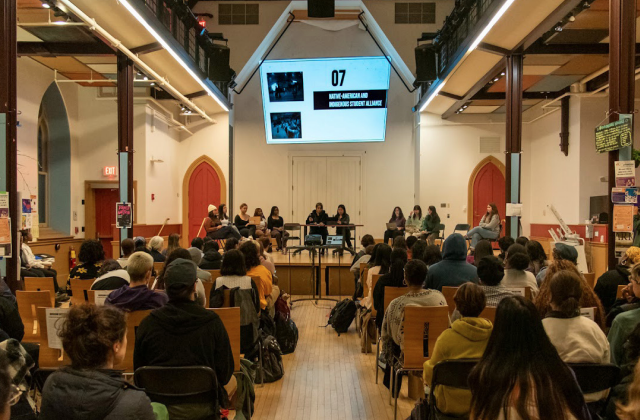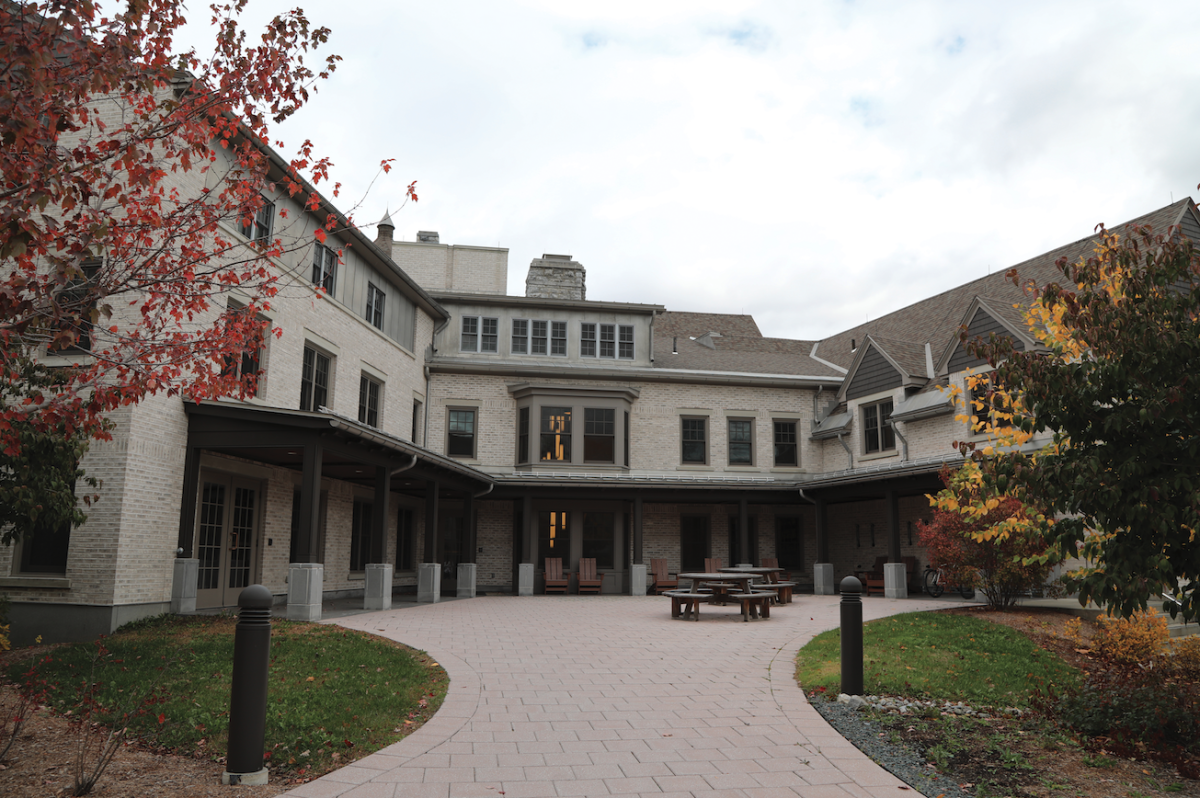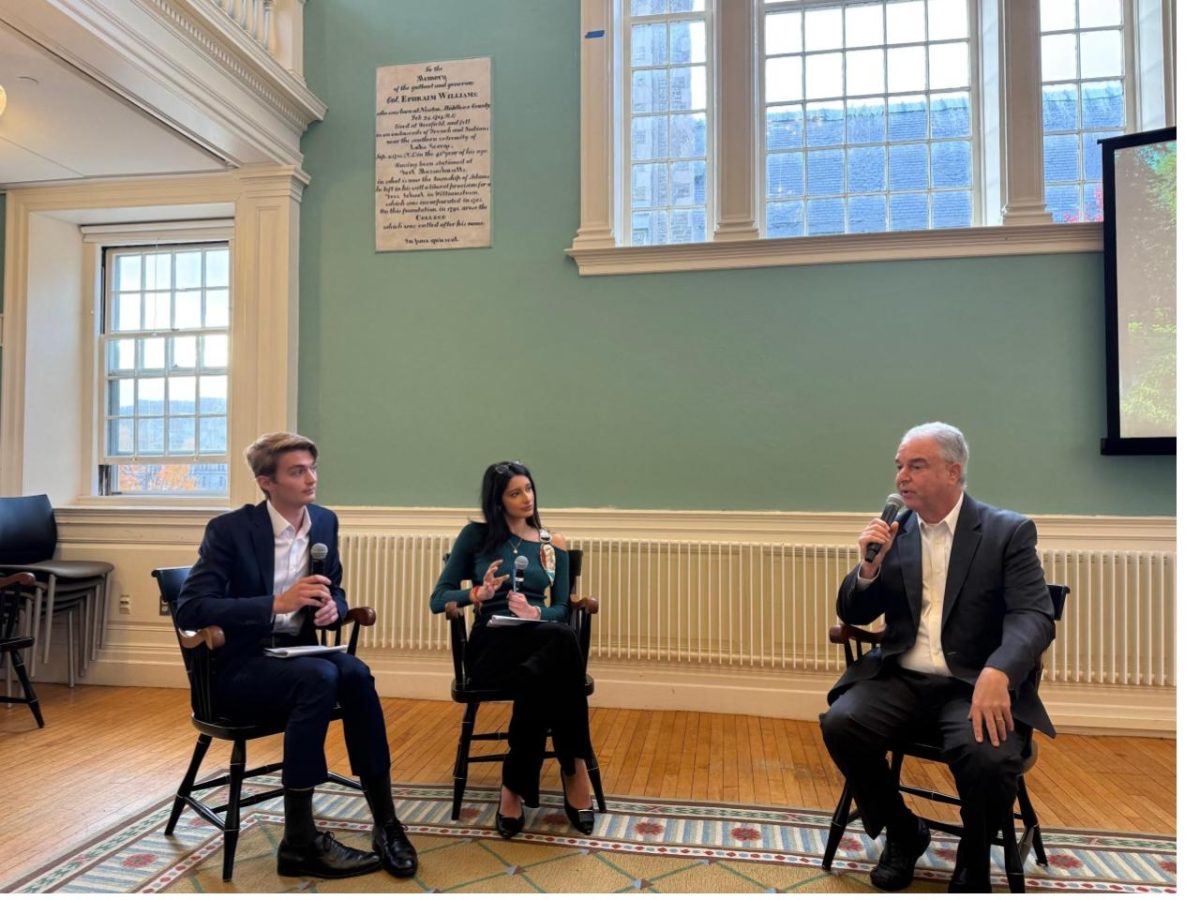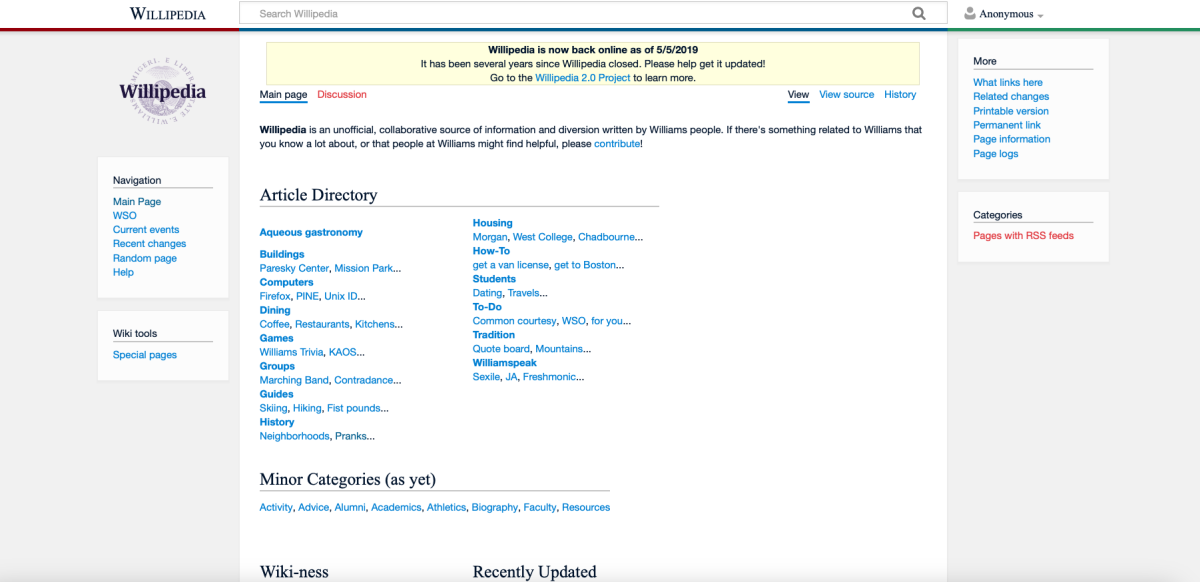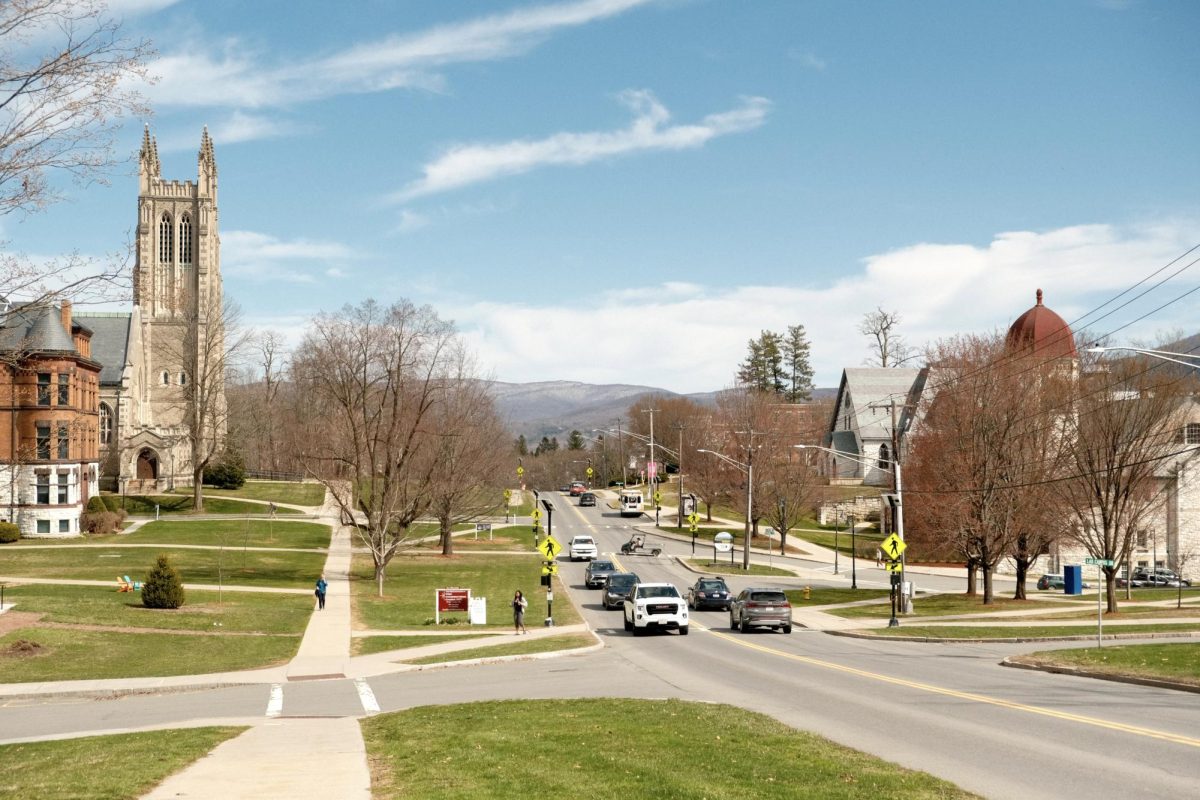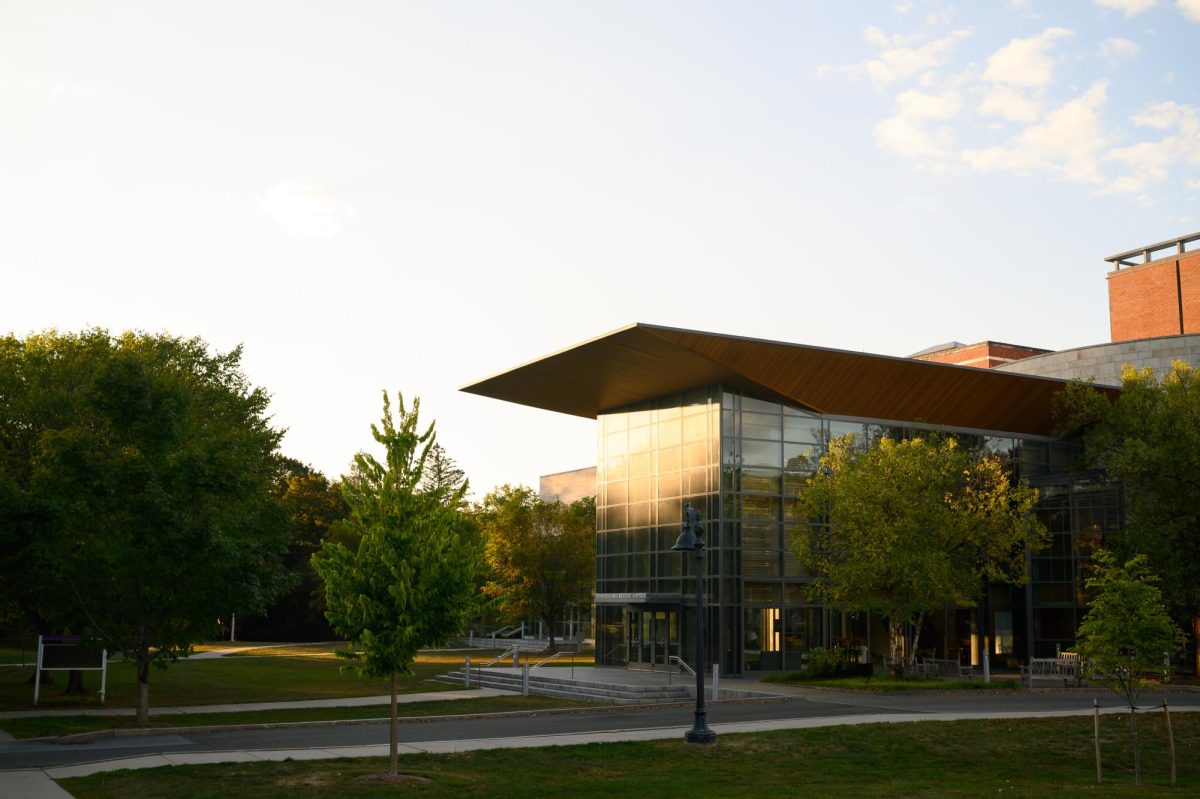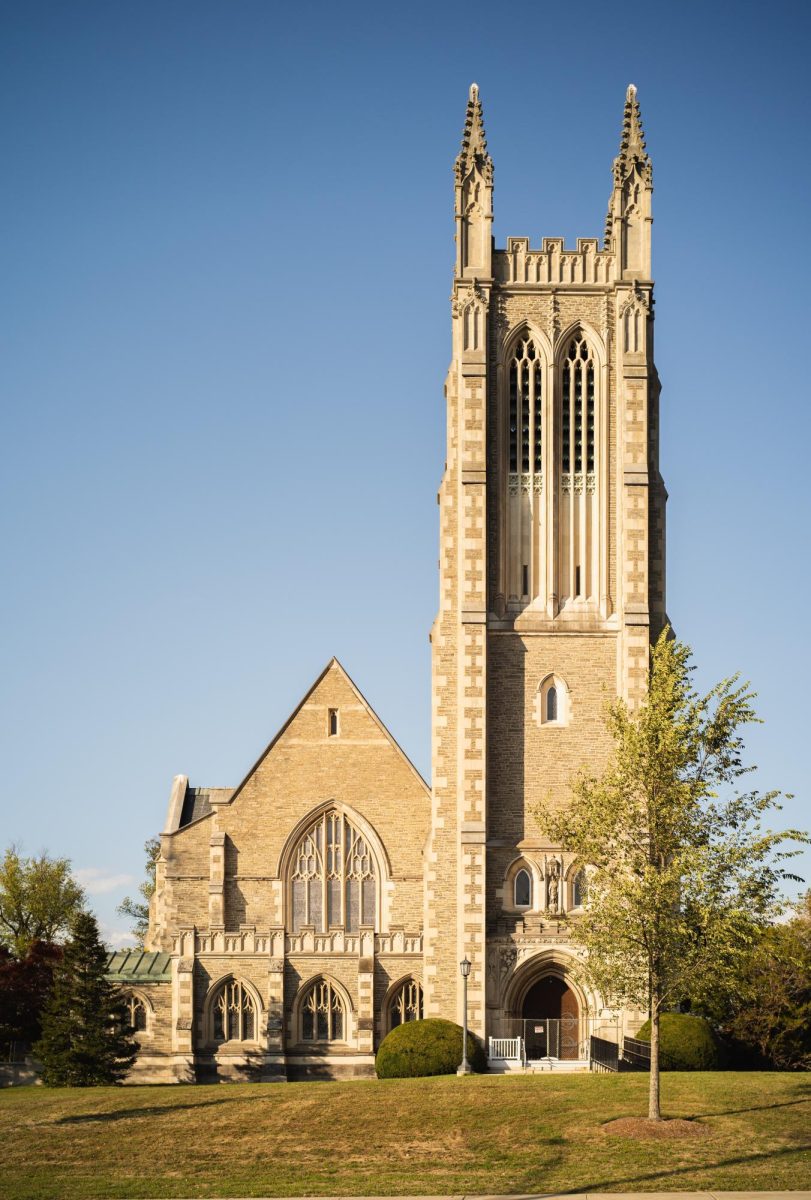Asian American Students in Action (AASiA), Black Student Union (BSU), Native American Indigenous Students Alliance (NISA), and Vista hosted their annual teach-in on ethnic and Indigenous studies at Goodrich Hall on Monday.
The teach-in covered the history of the four affinity groups, as well as the ongoing relationship between the College and the Stockbridge-Munsee Mohican tribe. Earlier this year, Berenize Garcia Nueva ’24 and Daisy Rosalez ’25 founded NISA, the College’s first Indigenous student group created by students of Indigenous descent. In recent years, the teach-ins have focused on similar topics like discussing the history of affinity groups on campus, but this year, the teach-in’s presentation also includes NISA.
Garcia Nueva and Rosalez began the teach-in with a land acknowledgment.
Afterward, Gwyn Chilcoat ’24 and Hikaru Hayakawa ’24 spoke about the College’s recent collaborations with the Stockbridge Munsee-Mohican tribe. In 2021, Chilcoat and Hayakawa founded the Mohican Nation Independent Study Program, in which students visited tribal heritage sites and developed policy proposals to increase the visibility of the Stockbridge-Munsee Mohican community on campus. “The work to dispel false narratives and implement policy proposals based on our independent study is ongoing,” Chilcoat said. The independent study program was advised by Professor of History Christine DeLucia, former Mellon Postdoctoral Fellow in Native American and Indigenous Studies Margaux Kristjansson, and Bonney Hartley, tribal historic preservation manager for the Stockbridge-Munsee Mohican Nation.
Chilcoat and Hayakawa also provided an overview of the College’s history with the tribe, discussing its displacement to western New York and then to Wisconsin.
They then explained how the College maintains its relationship with the tribe through internships at the Tribal Historic Preservation Office, student advocacy, and work by the Native American and Indigenous Working Group. They also discussed ongoing policy recommendations by students, such as honoring Indigenous People’s Day as a standalone holiday and removing colonial monuments and plaques from campus.
Hayakawa reflected on the growing student advocacy for Indigenous studies at the College. “After presenting [at the teach-in], the number of students in our group chat to push for Indigenous studies at Williams grew to 93,” Hayakawa wrote in an email to the Record. “Indigenous studies continues to be an important need at Williams: There is so much interest, but not enough faculty or classes.”
Mimi Johnson ’26, BSU’s political activities coordinator, and Nadia Joseph ’25, BSU’s historian, then spoke about the Third World Liberation Front and the history of BSU and Africana studies at the College.
Joseph also spoke on cross-community collaboration that preceded that at the College, discussing the efforts of students at UC Berkeley and San Francisco State University (SFSU). These students advocated to create an ethnic studies program at UC Berkeley and Black studies program at SFSU. “This is just an early example of a catalyst to this collaboration among ethnic groups even in California,” Joseph said.
Joseph said that in 1967, Black students founded the Williams Afro-American Society (WAAS), which would later become BSU in 1972. On March 12, 1969, WAAS provided the College administration with 15 demands grouped into three categories: the creation of an Afro-American studies program, greater administrative support for Black students, and an emphasis on admitting and recruiting more Black students. On April 4, 1969, WAAS occupied Hopkins Hall to call for administrative action. As a result, the first Black faculty member on the tenure track, Professor of Afro-American studies Joseph E. Harris, was hired, and the Afro-American studies program, later named Africana studies in 2006, was founded.
During the teach-in, Johnson also reflected on the Africana studies major. “The major is extremely important to a robust liberal arts education, tying Williams into a long history of the oppression and continued suffering of Black people,” she said.
Joseph also discussed the more recent history of the College’s Black community, including the 2022 placement of Eban House, Black affinity housing, in Wood House.
“This moment is extremely important in our history with regards to reclamation and occupying space on this campus,” she said. “Wood House was formerly a fraternity house for the Zeta Psi fraternity. Fraternities were only open to white male students and excluded the other racialized groups on campus, and Black students reclaiming that space is something that is especially powerful.”
Next, Mariel Baez ’26, Vista’s historian, Lucia Rios ’24, Vista’s MinCo representative, and Daniela Sanchez ’24, one of Vista’s co-chairs, presented on the history of Vista and Latina/o/x studies at the College.
In 1988, students occupied Jenness House, now a part of the upcoming Davis Center, with three demands: a required course about the history and culture of Black, Latinx, and Asian American communities; the addition of two visiting professor positions for two Latinx individuals; and one Black and one Latinx tenure-track professor for any Division 3 department. After the College did not meet these demands, students staged a hunger strike in 1991. Two years later, students staged another hunger strike, which lasted four days, protesting the lack of a Latina/o/x studies program. The College did not hire Chair of Latino/a/x Studies and Professor of History Carmen Whalen, the first tenure-track Latina/o/x studies professor, until 2001. The Latina/o/x studies program would not be officially implemented until 2004.
Next, Serah Park ’26, one of AASiA’s co-chairs, Audrey Liu ’26, one of its treasurers, and Lamia Haque ’25, its MinCo representative, presented about the history of AASiA and the Asian American studies movement at the College. Park said that the initial proposal for the Asian American studies program was rejected in 2004. In 2012, an external review of the College’s American studies program conducted by professors at University of Massachusetts Amherst, Amherst College, University of Michigan, and the University of Washington unanimously decided that Williams needed an Asian American studies program. Faculty approved the creation of the Asian American studies program in 2022, 34 years after initial student activism began.
Liu followed Park’s presentation by discussing the 2018 disruption at Jamboree and the “Williams Doesn’t Teach Me” photo campaign, led by AASiA in [year]. In 2021, Assistant Professor of American Studies Kelly Chung was hired after a bid for a second Asian Americanist.
This semester, the College offers seven Asian American studies classes and has no administrative assistant for the program. Haque urged students to attend an AASiA meeting on Nov. 1 to push for the hiring of an administrative assistant and more faculty.
“Ethnic studies provides us with frameworks to think about current events in a productive manner,” Liu said.
Lastly, Garcia Nueva and Rosalez presented on the history of NISA. In 1999, the Native American Student Alliance at Williams (NASAW) was established by Elizabeth Hoover ’01. The College hosted its first pow-wow in 1998 and its last pow-wow in 2001. The group would become inactive the following year — and students did not form another Indigenous student group for 20 years. In 2023, Hoover issued a statement of apology for falsely claiming Mohawk and Mi’kmaq ancestry, making NISA the first Indigenous student group founded by students of Indigenous descent at the College.
Garcia Nueva and Rosalez then discussed NISA’s goals for the future, including the creation of opportunities for Indigenous students to celebrate their heritage through ceremonies, art, food, and storytelling. “Every Native and Indigenous student at Williams is automatically a member of NISA,” they said. “NISA welcomes any member of the Williams student community interested in learning about Native and Indigenous social, cultural, and intellectual engagement and becoming an ally.”
To conclude the presentation, Haque presented a list of demands compiled by the student groups. Among the demands are more faculty, courses, and resources for all ethnic studies programs, faculty, and students, greater communication with students regarding hiring and retention of faculty of color, and the creation of an Indigenous studies program at the College.
Students were then invited to engage in a discussion reflecting on the presentation and enjoy a catered dinner by BB’s Hot Spot, a Caribbean-American restaurant in Pittsfield.
Attendee Ingrid Colafati ’26 told the Record that the teach-in was incredibly eye-opening. “I found the recency of the progress outlined in each presentation striking — it speaks to how the present moment has to be one of continued change and action,” she said.
Park provided her reflections about organizing the teach-in to the Record. “I hope that the College recognizes that Williams cannot pride itself on being a top liberal arts college without a robust ethnic studies program,” Park wrote in an email to the Record. “Ethnic studies courses provide us with the foundations and frameworks to think about current events that are, without fail, rooted in centuries of historical precedents. Ethnic studies benefits every student, and we need it now, more than ever.”
A previous version of this article incorrectly stated that only two Asian American Studies classes were offered during the fall 2023 semester – this was true during the fall 2022 semester.



